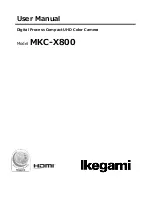
Description — Screening station (Auto and Button mode)
Note
The setup as described in this section is adapted for persons with an average
height of 170 cm (5.6 ft.). With this setup, the system will screen persons with a height of
150-195 cm (4.9–6.4 ft.). To adapt the setup for other average heights, see section 10.4
.
11.3
Screening station considerations
For accurate screening results and an efficient screening flow, the following factors re-
lated to the screening station area should be considered.
Screening accuracy
• Screening is best with room temperatures maintained below 24°C (76°F) and relative
humidity below 50 %.
• Screening should be carried out in an area with no air movement, out of direct sun-
light, and away from heat sources.
• Avoid locations with reflective backgrounds (e.g. windows, glass doors, or metallic
surfaces).
Equipment
• The screening equipment is intended for indoor use.
• Decide where the visitor display and the camera shall be placed and how they shall
be mounted.
• The screening equipment shall preferably be placed so that the operator can see the
screening station and be of guidance to the screened persons.
• It can be useful to have a secondary display for the operator, e.g. on the reception
desk.
• Power outlets are needed for the camera, computer, visitor display, and any operator
display.
• Avoid reflections in the visitor display. Otherwise, it can be difficult for the visitors to
see the graphics and messages on the display.
Visitors and queueing
• Plan how the visitors will flow into the screening station and out, both in low and high
flow periods. Plan for any alternative routes, e.g. after an alarm, for any questions, for
persons in a wheelchair or with other special requirements.
• Consider personal integrity matters; e.g. if the visitor display should be hidden from
others than the screened person. See also section 11.4
.
• Allow for appropriate distancing between people in the screening queue.
• Allow for people to stabilize their temperature if it was raised by exercise or physical
activity.
11.4
Company policies
The FLIR EST screening system only detects elevated skin temperatures. It is up to your
company to set up a suitable screening process in accordance with applicable local data
protection, employment, and health and safety laws.
These are some of the factors your company need to consider:
• Personal integrity
Make decisions on how to handle personal integrity, e.g. show/hide the visitor display
for others than the screened person, have/not have a sound alarm.
• Process for alarms
Establish a process for those individuals where the system has indicated an elevated
temperature, e.g. let the person sit down for 10 minutes and then do the screening
again, further evaluation by medically trained personnel.
• Visitor information
Provide visitors with information and instructions about the screening, e.g. by roll-ups.
#T810583; r. AA/75420/75423; en-US
50
















































